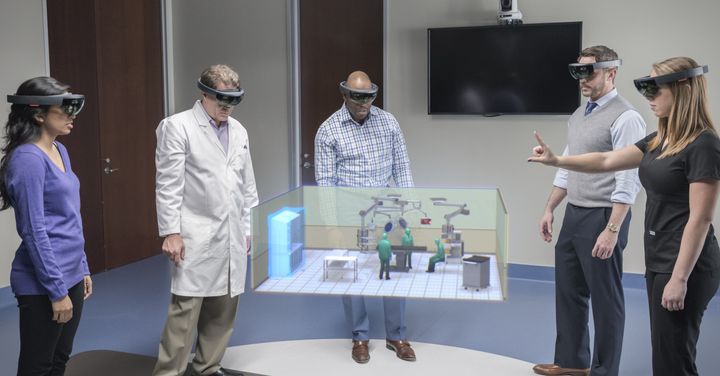
There is a battle raging in technology circles between AR and VR. Augmented Reality, likened to going to the aquarium, is competing with Virtual Reality, akin to swimming with the sharks. 2016 seemed to promise much, with the launch of some major virtual reality kit that should have dominated the year. It seems 2016 was the year in which we used technology to enhance our world rather than opting for an immersive reality that takes us to somewhere else entirely.
Will VR always be the daddy?
Star Trek fans will tell you that the holosuites signal the ultimate advance in gaming. These rooms allow deep space explorers such as Captain Picard and Kirk to experience other worlds and fight hand to hand with seemingly real aliens. The allure of such an immersive technology has led the media and the public to become obsessed with virtual reality's possibilities for taking us away from our world.
The giants of technology: Google, Facebook and Sony have been focused intently on developing the virtual technology. 2016 saw the emergence of Rift, Samsung Gear VR, HTC Vive, and PlayStation VR but the price point for the tech was anticipated to be prohibitive. Facebook acquired Oculus in 2016, which promised a market ready headset within a reasonable budget of $350.
The Samsung Gear VR allowed VR through a mobile device, which seemed the right step forward at the end of 2015. So, despite concerns, hardware advances should have made 2016 a triumphant year for VR. But because nobody thought it would work, or felt that the mass market couldn't afford it – no one was ready – not the market or the accessories manufacturers. The game developers did not really come to the party, and a lot of the development in software is slated to begin in 2017. So, not so much the year of VR as the possibility of VR, maybe? Developers are busy just trying to understand what works never mind applying the lessons to a product.
Yet, such is the sense of anticipation, the desire created by years of dreaming about VR, the Rift had so many orders when the product went live that delivery had to be put back at least a month – even at the weighty cost of $600 per unit. Even the Virtual Reality Society places a hint of caution about the idea that demand outstripping supply is a measure of VR's success in 2016.
The real question is not how many they can sell, but how many they can make.
That will be the limiting factor to early adoption. So, the complexity of making the product makes scalability a real issue. This means that big name software developers are not going to want to invest huge sums in providing a range of VR experiences, even in 2017. It is likely that the first VR experiences are going to have to be provided free, as sponsored products.
The case for AR

Oddly, the idea of technology that can add to reality has been a long-standing vision of Science Fiction. According to the Guardian newspaper, Baum, author of The Wizard of Oz imagined a pair of glasses that could add details to the world. Terminator showed how Arnold Schwarzenegger's vision was enhanced with data and a biomedical scanning capacity.
Before we can go any further, we need to bring the small yellow furry creature from out of the corner. The phenomenon of Pokemon Go must be the main argument for awarding the year of 2016 to AR technology. Game makers were always going to be the leading power in developing this reality-altering tech, and Pokemon Go found a way to use augmented reality through something most people already owned: a standard smartphone. There were people in their tens of thousands wandering around following imaginary creatures on maps – gamers were scurrying over fields and through city centers everywhere.
Snapchat also helped AR to rule the roost in 2016. The Geofilters and lenses were improved over the course of the year. This meant that Snapchat users could enhance the reality of the photo before sending it through to their network.
A solid argument for AR being the king of 2016 can be found in the facts and figures. First things first, AR enjoyed the creation of its own Venture Capital group in 2016. This is something that VR has enjoyed for a while, and the fascination of the giants of tech seem to place one VC group in the shade firmly. However, it does suggest that AR is finding its feet. Then, there are the projections for future value. According to ExtremeTech:
Analyst Digi-Capital predicts an AR market of $90 billion annually by 2020, compared to $30 billion for VR.
It is likely, after seeing the phenomenal success of Pokemon Go, which developers anticipate an extraordinary appetite for AR that makes it the victor of 2016. Yet, there is a counter argument that needs to be taken seriously. AR does help to improve our world, rather than take us away from it – which could be a plus. However, that pesky desire to be fully immersed is powerful. AR still provides only a very narrow field of vision. We are looking at this reality from a long way away. Also, AR of any complexity requires a lot of processing power, which could be solved with the use of a cloud but currently still means applications are limited to overlaying simple digital lenses. Project Tango, when applied by mere mortals in their own home, showed nothing of the clarity and impressive quality of the demonstrations.
So, who won the battle for the year 2016?
The question is: did AR sneak up on its big brother VR and steal all the glory of 2016? The answer must be... well, yes it did really. At the end of 2015, everyone was getting all hot under the collar that finally VR was going to be mainstream, and we could enjoy another reality without vomiting violently. Then, nothing really happened because no one was really expecting it to be true.
On the other hand, what felt like out of nowhere, came a phenomenal success with AR that enhanced the world we lived in. Suddenly, it was fun again to play out in the streets. So, because AR allows for technological evolution that is gentle, enabling developers to keep up with hardware capacity, it is fair to say that AR stole the crown and the glory from VR in 2016.
